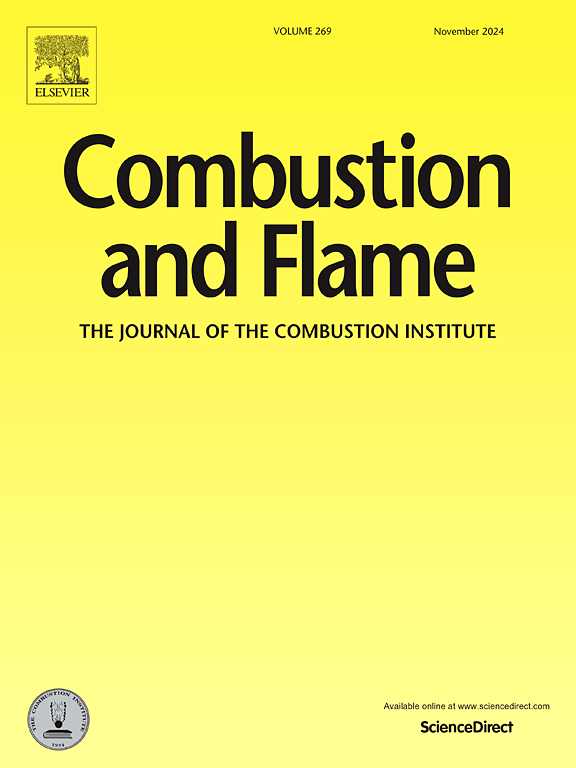SkeleCHy: A skeletal mechanism for low hydrocarbon content blends with hydrogen
IF 5.8
2区 工程技术
Q2 ENERGY & FUELS
引用次数: 0
Abstract
In order to achieve short-term reductions in carbon dioxide emissions, combustion systems may be retrofitted to operate with blends of methane and hydrogen. However, the volume fuel fraction of hydrogen must be at least 70% to achieve significant reductions in carbon dioxide emissions. Comprehensive chemical kinetic mechanisms can be used to simulate these high hydrogen content hydrogen/methane blends but such mechanisms are computationally demanding, especially when nitrogen chemistry is included. However, formation of nitrogen oxides () is one of the major factors to consider for the transition towards hydrogen-fuelled carbon neutrality. This motivates development of a skeletal mechanism that can capture the key attributes of laminar combustion, which are the burning velocity, ignition delay time, distribution of major species and emissions, and the extinction strain rate. To identify the best available base mechanism for the chemical mechanism reduction process, an extensive experimental database of approximately 2000 data points is considered explicitly for volume fuel fractions of hydrogen of 70% or greater and the performances of several commonly employed mechanisms are reviewed. State-of-the-art chemiluminescence kinetics as well as nitrogen chemistry are added to the best available comprehensive mechanism. A skeletal mechanism, SkeleCHy, is derived with quasi-steady state assumptions, the directed relation graph with error propagation method and isomer lumping. The reduction is validated with approximately 2200 data points and the skeletal mechanism is further validated with a subset of approximately 330 experimental data points of high interest. It is demonstrated that the key attributes of laminar combustion for hydrogen/methane–air mixtures with high hydrogen content with unburnt mixture temperatures of to and operating pressures of to are captured while the computational cost of the SkeleCHy mechanism is comparable to the commonly used GRI 3.0 mechanism. Novelty and significance statement: The fuel volume fraction of hydrogen in hydrogen/methane fuel blends targeting decarbonisation is at least 70%. Emissions of NO are a concern in this blending regime and chemiluminescence is frequently used for validation of simulations. It is therefore of high interest to find the best available chemical kinetic mechanism for this fuel blending regime. This work is the first to assess chemical kinetic mechanisms explicitly in this fuel blending regime using an extensive database of experimental measurements. A skeletal mechanism is developed to be used specifically for this fuel blending regime, filling a hole in the current range of reduced mechanisms for combustion of hydrogen/methane blends. This is to achieve significantly lower computational cost but maintain accurate estimations of the key attributes of laminar combustion for reactant temperatures of 300 to 700 K, atmospheric pressures to 10 bar and hydrogen fuel volume fractions of at least 70% with methane. The skeletal mechanism is heavily validated using the measurements and the comprehensive mechanism.
求助全文
约1分钟内获得全文
求助全文
来源期刊

Combustion and Flame
工程技术-工程:化工
CiteScore
9.50
自引率
20.50%
发文量
631
审稿时长
3.8 months
期刊介绍:
The mission of the journal is to publish high quality work from experimental, theoretical, and computational investigations on the fundamentals of combustion phenomena and closely allied matters. While submissions in all pertinent areas are welcomed, past and recent focus of the journal has been on:
Development and validation of reaction kinetics, reduction of reaction mechanisms and modeling of combustion systems, including:
Conventional, alternative and surrogate fuels;
Pollutants;
Particulate and aerosol formation and abatement;
Heterogeneous processes.
Experimental, theoretical, and computational studies of laminar and turbulent combustion phenomena, including:
Premixed and non-premixed flames;
Ignition and extinction phenomena;
Flame propagation;
Flame structure;
Instabilities and swirl;
Flame spread;
Multi-phase reactants.
Advances in diagnostic and computational methods in combustion, including:
Measurement and simulation of scalar and vector properties;
Novel techniques;
State-of-the art applications.
Fundamental investigations of combustion technologies and systems, including:
Internal combustion engines;
Gas turbines;
Small- and large-scale stationary combustion and power generation;
Catalytic combustion;
Combustion synthesis;
Combustion under extreme conditions;
New concepts.
 求助内容:
求助内容: 应助结果提醒方式:
应助结果提醒方式:


